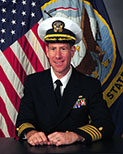


Spectroscopic Biomarkers for Monitoring Wound Healing and Infection in Combat Wounds
Posted January 29, 2013
CAPT Eric A. Elster, M.D., Naval Medical Research Center, Silver Spring, MD
 Modern blast injuries to the extremities such as those sustained in combat are complex and devastating, with extensive damage to soft tissue, bone, nerves, and the vasculature. Care of these injuries is a multifaceted effort aimed at promoting wound healing, preventing infection and other complications, and restoring function of the affected limbs. Surgeons need to be able to accurately diagnose an injury, assess tissue and overall limb viability, and monitor the wound during the healing process in order to identify and facilitate the appropriate treatment for patients.
Modern blast injuries to the extremities such as those sustained in combat are complex and devastating, with extensive damage to soft tissue, bone, nerves, and the vasculature. Care of these injuries is a multifaceted effort aimed at promoting wound healing, preventing infection and other complications, and restoring function of the affected limbs. Surgeons need to be able to accurately diagnose an injury, assess tissue and overall limb viability, and monitor the wound during the healing process in order to identify and facilitate the appropriate treatment for patients.
To aid in this process, Dr. Eric Elster strives to understand the relationship between wound healing and the overall response to injury. Through funding from a Fiscal Year 2009 (FY09) Peer Reviewed Orthopaedic Research Program Idea Development Award, Dr. Elster and his colleagues have created a bench-to-bedside approach that examines both the physical wound patterns of injury and the body's response to that injury in data collected from wounded warriors being treated at the Walter Reed National Military Medical Center and an array of animal and in vitro experiments. The team is integrating four different spectroscopic technologies, infrared imaging, near-infrared spectroscopic imaging, visible reflectance spectroscopic imaging, and Raman spectroscopy, into a clinically deployable system. The multi-modal approach allows for a global, non-invasive, real-time assessment of critical parameters such as tissue temperature, perfusion, hypoxia, collagen deposition, and development of calcified tissue. Data collected from the imaging and follow-up clinical outcomes will be used to develop a predictive model for wound healing, limb viability, and the development of heterotopic ossification.
The approach developed by Dr. Elster and his colleagues is already identifying critical modulators of the local inflammatory processes and ultimately will assist clinicians at key decision-making points, such as in accurate wound debridement, determining the optimal wound closure time, and developing better indicators for limb salvage versus amputation in military populations. Excitingly, Dr. Elster has recently been recommended for funding by the FY12 Joint Warfighter Medical Research Program to expand his research to the civilian trauma setting. This continuation will refine traumatic wound assessment techniques and transition the advancements to a setting that will allow them to foster and advance medical practice as current military conflicts abate.
Publication:
Crane N. J., Elster E. A. (2012). Vibrational spectroscopy: a tool being developed for the noninvasive monitoring of wound healing. Journal of Biomedical Optics 17(1):010902.
Links:














